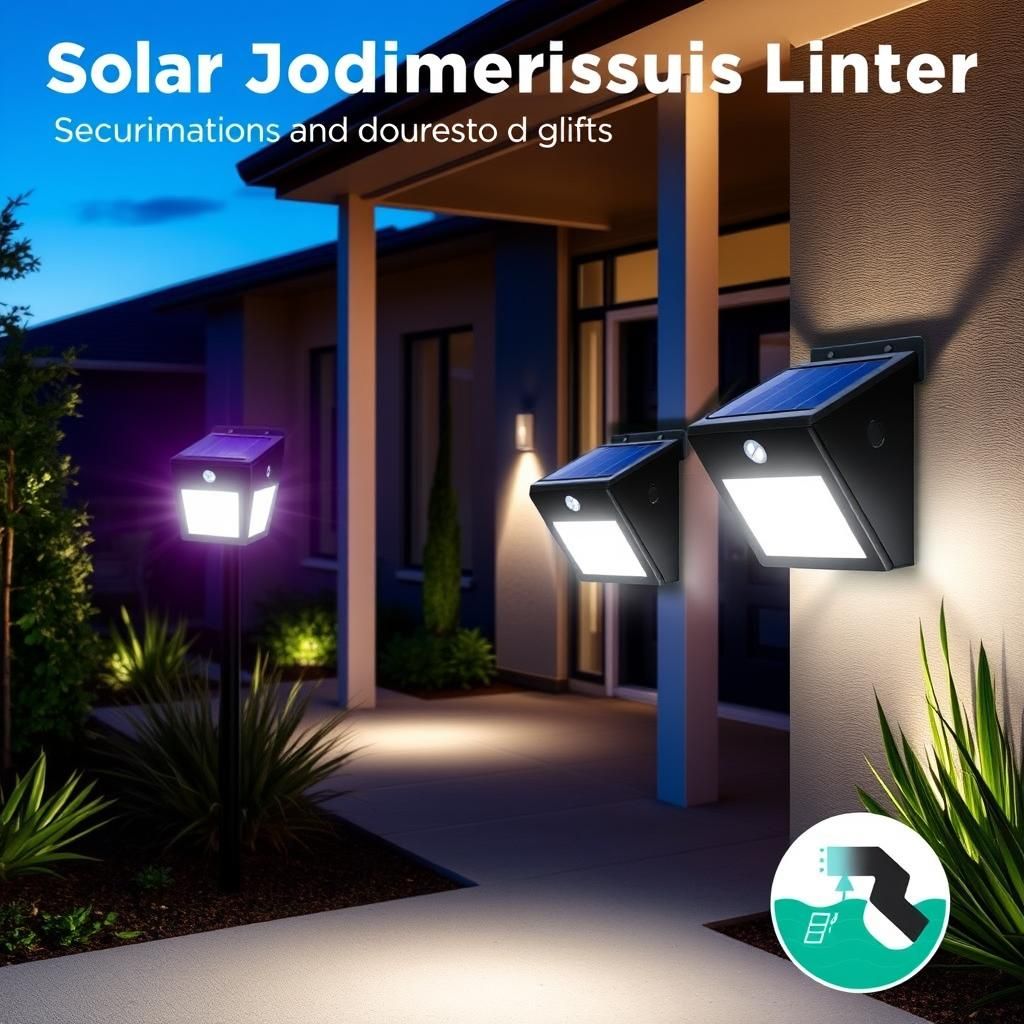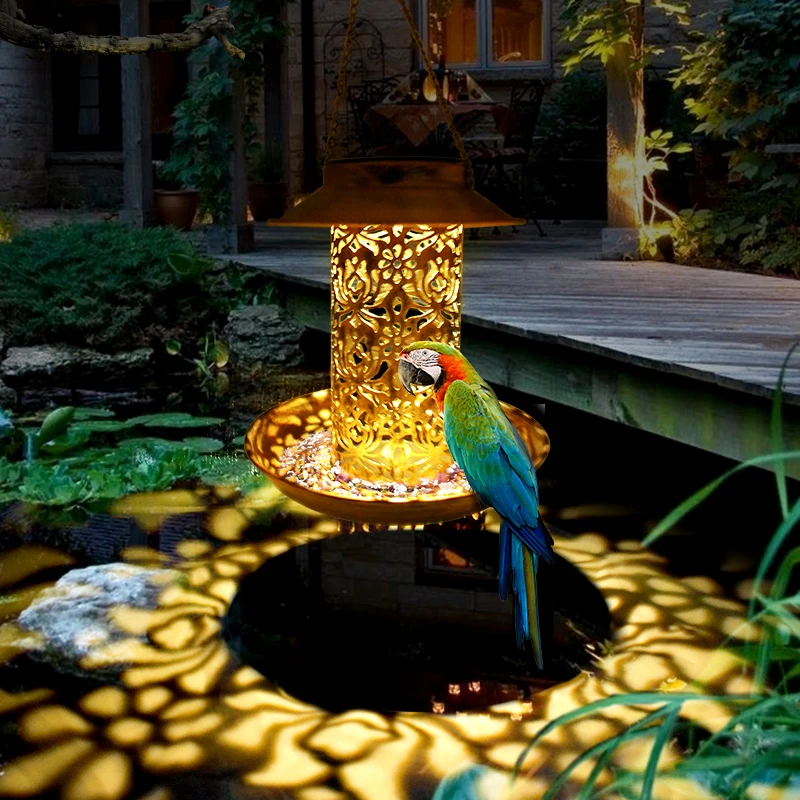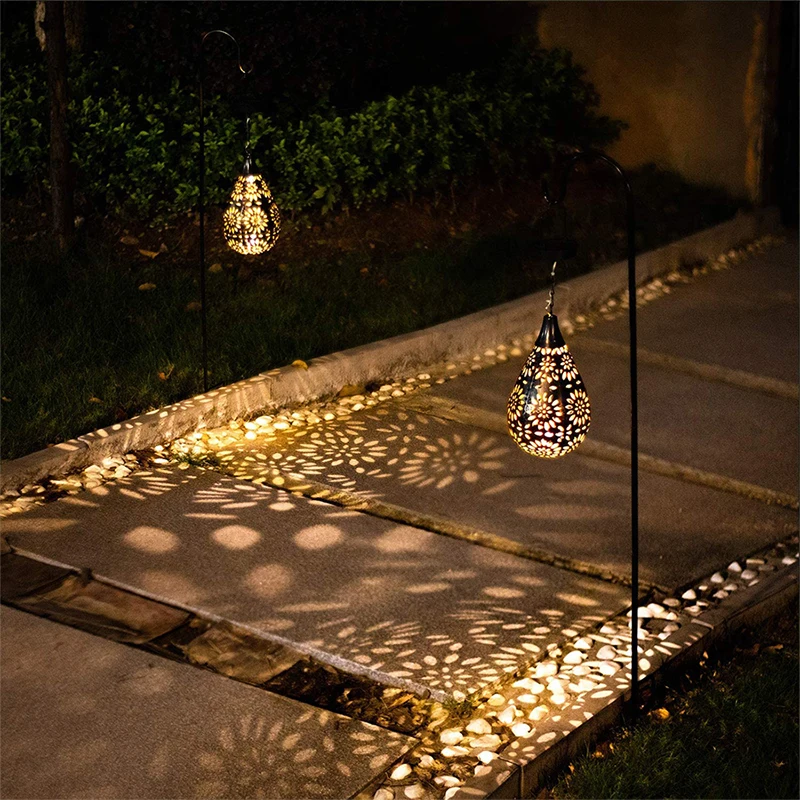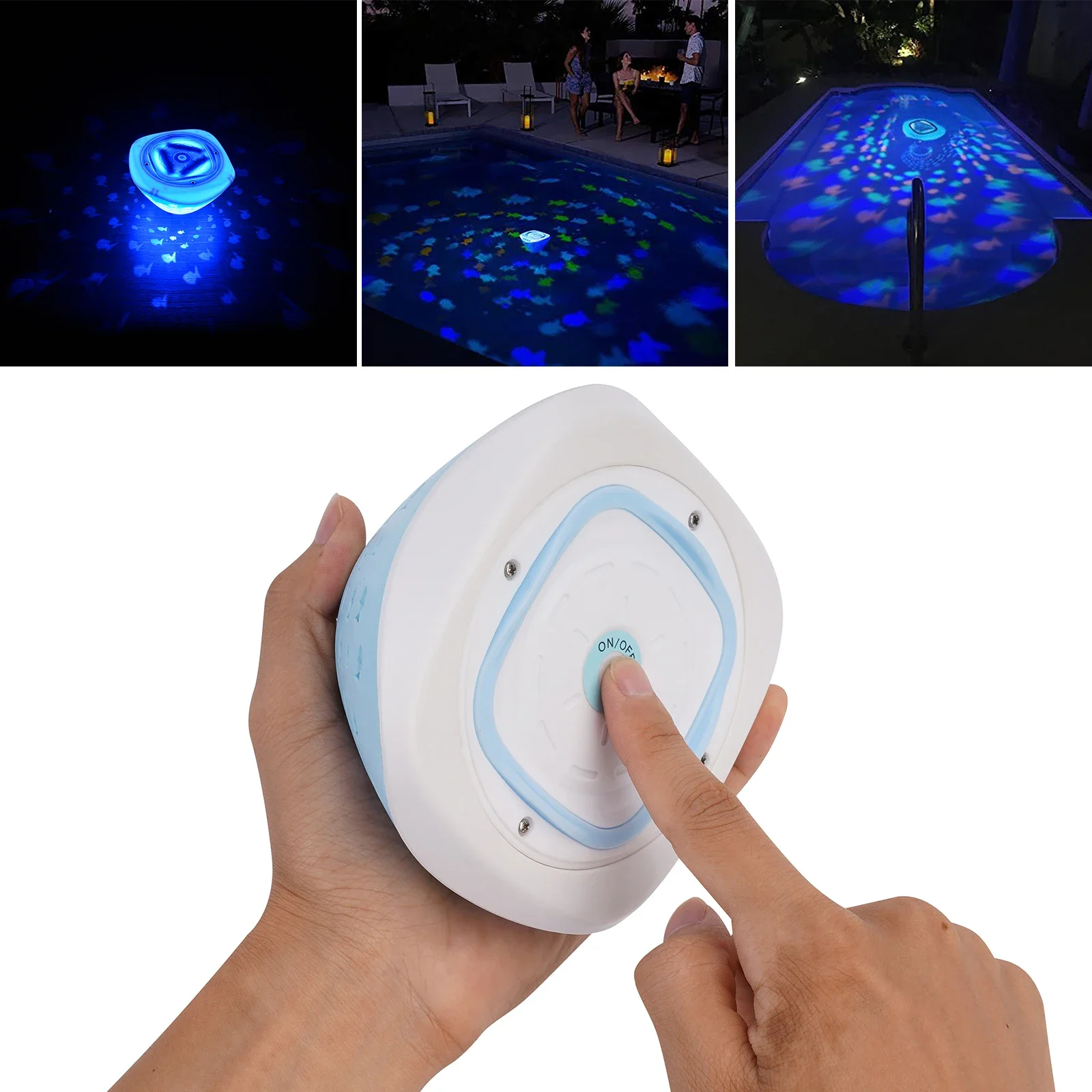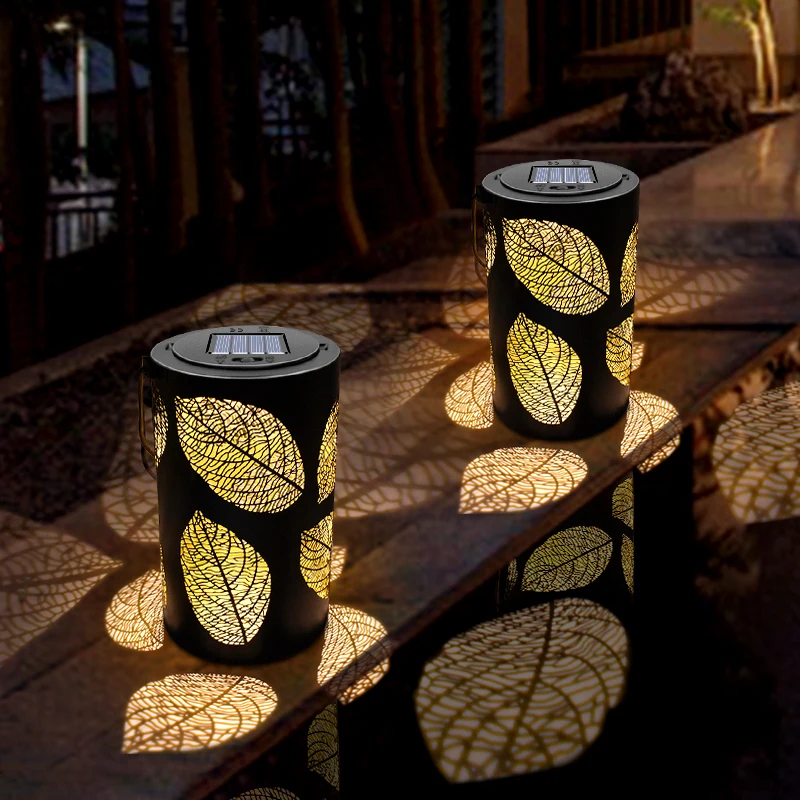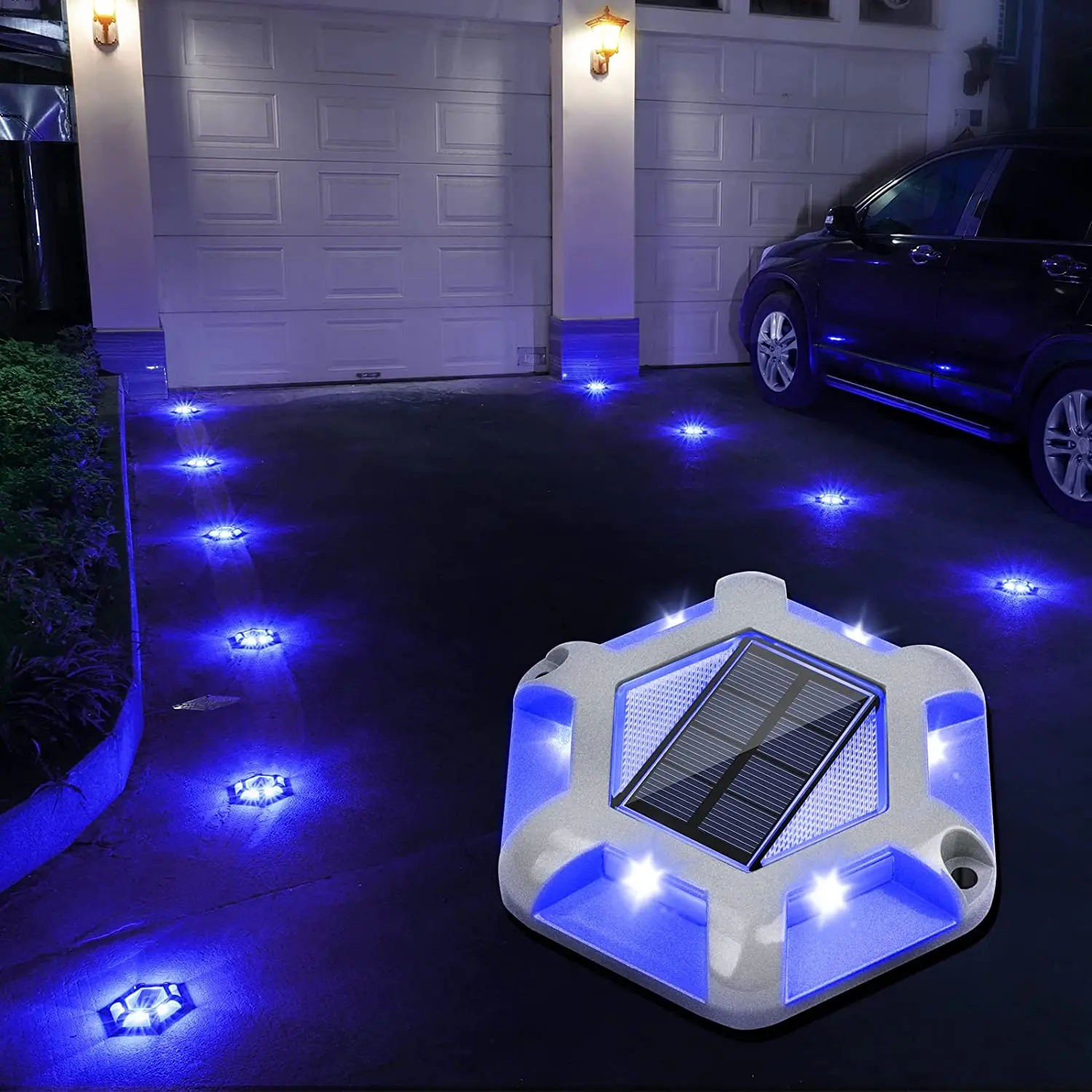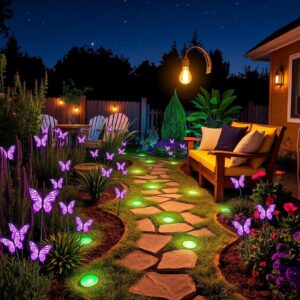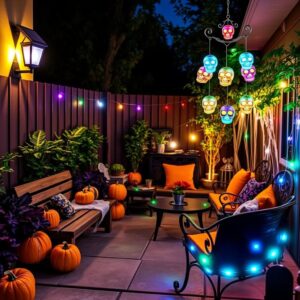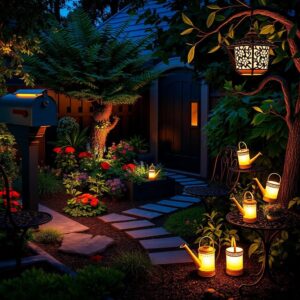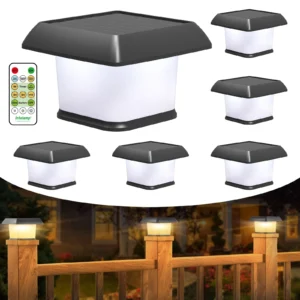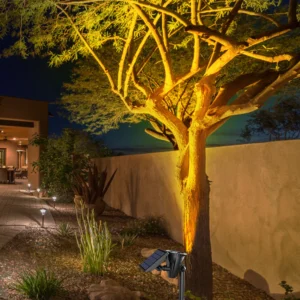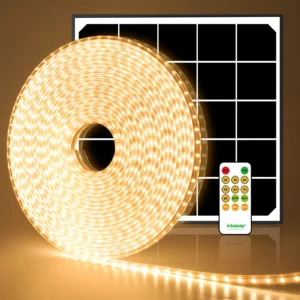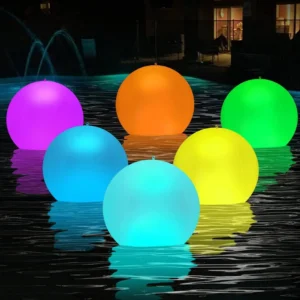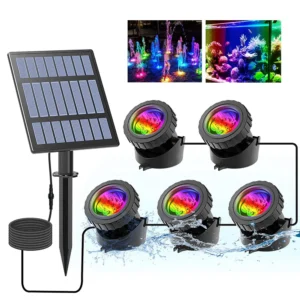Solar Light Bird Feeder – Outdoor Decorative Lamp and Bird Feeder
Introduction
What Are Outdoor Solar Motion Sensor Lights?
Picture this: you walk down your garden path at night, and like magic, the shadows retreat as a gentle flood of light follows your steps. That’s the heart of an outdoor solar motion sensor light. These lights are self-contained fixtures combining small solar panels, rechargeable batteries, and built-in motion sensors—ready to spark to life whenever movement is detected.
Their purpose goes far beyond simply illuminating your yard. Let’s keep it simple: solar motion lights are your effortless security guards and energy-saving companions in one neat package. They help ward off unwanted visitors (human or critter), light your way without fumbling for switches, and keep your property safer—all while running on solar power, not your electric bill.
Install one under your porch, by the garage, or along a dark path. The second the sensor spots motion—be it you returning home, a friend popping over, or that raccoon eyeing your trash bins—the light kicks in. After a set time, it quietly turns off, using energy only when needed. No more stumbling in the dark. No wasted electricity. It’s smart, simple, and hands-off.
Why Go Solar in 2025?
You might wonder, “Why go solar now?”—especially with motion sensor lights. In 2025, there are better reasons than ever to make the switch.
First, the environmental upside is huge. When you choose a solar-powered motion light, you’re harnessing the sun’s energy—a free, clean source. Every evening your lights turn on, you’re skipping fossil fuel power, shrinking your carbon footprint, and making your home gentler on the planet. Multiply that across your neighborhood, and suddenly, you’re part of a quiet green revolution.
Second, you’ll see real savings. Solar motion sensor lights don’t add a cent to your energy bill. They charge themselves during the day, storing up sunshine for night duty. Because they only glow when movement is detected, they never waste electricity. Some estimates peg energy savings at 30–50% versus always-on lights—money back in your pocket month after month.
Third, installation is simple and flexible. No wiring nightmares, no outlet hunting. Mount them where you need them most—along fences, garages, garden sheds—without calling an electrician. Modern solar motion sensor lights are designed for everyday DIYers, with most needing only a screwdriver and a bit of sun.
Finally, 2025 brings big tech leaps. New models are brighter, better at sensing motion, and keep shining even after cloudy days. Batteries last longer, sensors are more accurate, and weatherproofing ensures year-round performance, even through snowy nights or muggy summers. These aren’t yesterday’s dim, unreliable solar lights. They’re smart, sturdy, and built for all conditions.
So if you want a yard that greets you with a glow, scares off intruders, saves money, and helps the planet—all with almost zero effort from you—solar motion sensor lights are about as future-ready as it gets.
Bottom line: Outdoor solar motion sensor lights brighten up security and comfort, minus the energy waste and wiring woes. As we head into 2025, these lights aren’t just a wise upgrade—they’re an easy win for your wallet and the world outside your door.
Outdoor Solar Chandelier | Solar Pendant Light with Metal Carvings
Key Features to Look for in Solar Motion Sensor Lights
Shopping for the best outdoor solar motion sensor lights is more than just picking the brightest option on the shelf. It’s about finding a balanced setup that combines security, convenience, and energy efficiency with enough ruggedness to stand up to the elements. Let’s strip away the hype and get practical—a great solar motion sensor light should reliably fade into the background by day, then be a total workhorse after sundown. Here’s what to watch for before you buy.
Brightness and Coverage
Think about what you’re actually trying to light up. Is it a narrow side path or the whole driveway? Brightness matters, and it’s usually measured in lumens. As a rule of thumb, the higher the lumens, the brighter the light. But don’t fall for “brighter is always better.” Too much glare can be like a security floodlight at a sports stadium—hard on your eyes and probably overkill for a quiet porch.
Start with a rough sense of your space: for small patios or entryways, 100–300 lumens is usually plenty. For those bigger stretches—a deep driveway, backyard, or side yard—a model with 500+ lumens and a wide coverage area will serve you well. Pay attention to descriptions about the “beam spread” or stated coverage distance; this tells you how much ground those lumens actually reach. Ideally, a good solar motion light should cast a broad, even field of illumination without leaving shadowy blind spots.
Motion-Sensing Technology
All the brightness in the world doesn’t help if your light doesn’t come on at the right moment. The core of these systems is the motion sensor—think of it as your home’s silent night watch. Modern solar motion lights mention “detection range” and “detection angle.” Here’s what that means for you:
- Range: How far away movement can trigger the light (often between 16–72 feet).
- Detection angle: The width of the area (measured in degrees) that’s actually covered by the sensor (e.g., 120° to 270°).
If your priority is to light up side entries or hidden corners, look for models with a wider angle and longer range. For tighter spaces, a slightly narrower sensor can cut down on false alerts from passing cars or neighborhood cats.
Some newer lights offer customizable detection zones and adjustable sensitivity. This lets you “aim” the sensor or dial down its sensitivity—great for busy streets where you only want the light activating if someone’s actually on your property. Customization can be a game changer: if your light goes off too often (or not enough), you’ll find yourself fiddling in the dark more than you’d like.
Energy Efficiency and Battery Life
Let’s keep it simple: your solar motion light needs to store enough juice during the day to keep things running all night. Look for battery capacity (usually stated in milliamp hours—mAh). Bigger numbers mean more stored energy, but it’s also about how efficient the unit is. An efficient light sips power and still gives you the brightness you need.
Recharge times matter, too. Most options charge up in 6–8 hours of direct sunlight, but if you live somewhere cloudy or have limited sun, seek out lights that perform well in low-light charging conditions. A great light should last 8–12 hours per night on a full charge.
Tip: Some lights offer energy-saving or “dim until motion-activated” modes. These options mean your battery lasts even longer, and you’re not leaving your yard lit up like a store display at 3 AM.
Weatherproof Design and Durability
Outdoor lights must withstand whatever weather gets thrown at them—downpours, dust storms, and wild seasonal temperature swings. Look for the IP (Ingress Protection) rating. This two-digit number tells you how resistant your light is to water and dust. For dependable performance year-round, go for IP65 or higher—that’s solid against rain, wind, even a little snow or dust.
But don’t just check the rating—read reviews or product notes about real-world durability. Are the housings sturdy? Do seals keep moisture from corroding the electronics? If you live somewhere with tough winters or blazing summers, make sure your light promises “all-weather” or “year-round” reliability.
Ease of Installation and Additional Features
No one wants a complex install—look for lights that can be quickly mounted with basic tools. Models that offer flexible mounting (wall, fence, eaves, poles) are practical, especially if you’re still deciding on the best spot.
Bonus features aren’t essentials, but they can make a difference:
- Remote controls or multiple lighting modes (steady, motion-only, dim+bright) give you control over your outdoor environment.
- Adjustable settings let you find the right mix of sensitivity, brightness, and timer duration.
- Swiveling light panels or moveable sensors help you customize where the light lands and which path it “watches.”
Remember, the best outdoor solar motion sensor lights blend right into your daily life—easy to place, tough enough for the elements, battery-smart, and always lighting up when you need them. Get these basics right and you’ll hardly notice your lights—until they’re doing exactly what you bought them to do.
Bubble Solar Pole Lights – Eco-Friendly Garden Lighting
Top Outdoor Solar Motion Sensor Lights for 2025: Reviews & Comparisons
Let’s face it: outdoor security shouldn’t be complicated or ugly. If you’re set on finding the best outdoor solar motion sensor light for 2025, you don’t want a glowing spreadsheet’s worth of stats—you want the best lights for real, everyday use. Here’s a straight-shooting guide to the top picks for this year, stripped down to what actually matters: brightness, durability, value, and ease.
AloftSun Motion Sensor Solar Landscape Spotlights
Some lights just… work. The AloftSun Motion Sensor Spotlights have nailed that. Start with the way they throw light—bright enough to truly illuminate a driveway, path, or backyard nook. When movement triggers their sensors, they react fast, shedding plenty of light where you actually need it.
Specs-wise, these are multi-mode spotlights, offering adjustable intensity and tight, focused beams. They’re engineered to hold up in different climates, shrugging off rain, cold, and summer sun. Installation? No hardwiring—just stake them into the ground or use the optional mounting.
Pros:
- Seriously responsive: Their motion sensors catch the smallest movements, so nothing sneaks up unlit.
- All-weather warriors: Built strong. Most owners see them last through winter chills and summer storms with zero fuss.
- Adaptable lighting: Multiple modes let you switch from bright security mode to a softer accent glow.
Cons:
- Higher price tag: These are not bargain-basement lights. You’re paying for quality—and it shows.
- May be overkill for tiny spaces: If your yard is micro-sized, you might not tap their full potential (but hey, your gnomes would be visible).
LEPOWER Solar Flood Light
Need to light up the whole side of your house? The LEPOWER Solar Flood Light sweeps wide—72 feet of coverage, making it a go-to for anyone who hates shadows and dark corners. These are floodlights in the truest sense, washing big areas with a broad, bright beam.
The motion sensor is dialed in, reliably detecting movement within an impressive range. Whether it’s the neighbor’s cat or a delivery driver, this light kicks on—no hesitation. Setup is simple but does take a sturdy mounting spot thanks to its larger solar panel and lamp head.
Pros:
- Massive coverage: If you want one light to handle a big backyard, garage, or long path, this is your friend.
- Top-tier motion sensing: Catches movement reliably, with few false triggers.
- Easy adjustability: The panels and heads tilt for just-right alignment with your space.
Cons:
- Requires more installation space: It’s big, and bigger means you need a proper surface or high post.
- Not for tight corners: Overkill for small patios or narrow entries—save these for wide, open spots.
WdtPro 2025 Solar Lights
For those who live where the weather’s a toss-up—storms one day, heat waves the next—the WdtPro 2025 Solar Lights have your back (and yard). Engineered to laugh in the face of heavy rain, dust, and frost, these lights come with top-shelf IP ratings for weather resistance.
They aren’t flashiest in advanced features, but they absolutely deliver where it counts: staying lit and functional when conditions are rough. Straightforward to install, these lights are a nice fit for budget-conscious buyers who don’t want to sacrifice durability.
Pros:
- Tough as nails: Rarely fazed by nasty weather, these lights have an IP score built for real-life conditions.
- Budget-friendly: You get dependable performance without draining your wallet.
- No-fuss install: Mounts up without tricky steps or convoluted programming.
Cons:
- Lacks advanced customization: If you want to play with detection zones or special settings, look elsewhere.
- Intensity best for small-to-medium areas: Great along a fence, walkway, or small patio, but won’t fully replace big floodlights for vast yards.
Comparison Table of Best Models
| Model | Brightness | Sensor Range | Battery Life | Weatherproof Rating | Best For ||————–|————–|————–|————-|———————|———————|| AloftSun | High | Wide | 8-10 hrs | IP65 | Customization, varied climates || LEPOWER | Very High | Very Wide | 7-8 hrs | IP65 | Large areas, flood coverage || WdtPro 2025 | Medium-High | Medium | 6-8 hrs | IP67 | Tough weather, affordability |
When it comes down to choosing the best outdoor solar motion sensor light for your needs in 2025, each of these options brings something distinct to the table. Want plug-and-play setup with powerhouse sensors? AloftSun shines. Is “cover every inch” your motto? LEPOWER’s broad sweep can’t be beat. Need lights that never quit, rain or shine? Grab the WdtPro.
In the end, think about your yard—not some hypothetical “perfect” space, but your actual corners, fences, and footpaths. Solar motion sensor lights aren’t just about numbers; they’re about real safety, convenience, and peace of mind—no matter what the weather (or your neighbor’s curious raccoon) throws at them.
Solar Light Moon Fairy Lamp for Outdoor Garden Decoration
Pros and Cons of Top-Rated Solar Security Lights
It’s one thing to rattle off specs; it’s a whole other game to decide what will actually work in the wild—your backyard, driveway, or that shadowy side fence you keep meaning to light up. Let’s put three top solar motion sensor lights side by side—AloftSun Spotlights, LEPOWER Flood Light, and WdtPro 2025 Solar Lights—and give you the clean, no-nonsense pros and cons of each. No hype. Just facts to help you nail your decision, avoid regret, and trust what you’re mounting.
AloftSun Spotlights
Pros
Serious brightness, quick on the trigger: AloftSun’s spotlights aren’t shy about illumination. Their motion sensors react fast—think less “glow” and more “instant daylight” when something crosses their path.
Flexible placement: These lights come with adjustable heads, making it easy to angle the beam exactly where you want—up a fence, across a walkway, or right on your door.
Lasts through the night (most nights): The battery lives up to the job after a full sunny day. Cloudy winter gloom? You might get a bit less, but for most, one charge lasts dusk till dawn.
Built tough: These are built to shrug off rain, heat, and a surprise cold snap. If you don’t want to fuss, AloftSun keeps things running.
Cons
Pricey: There’s no dancing around it—these spotlights cost a little more. If you’re covering a whole property, expenses add up fast.
Brighter isn’t always better: Not everyone wants a floodlight every time a cat slinks by. If your garden is a peaceful haven, you might find them a bit intense.
Advanced options take time: Customizing sensitivity and timings isn’t rocket science, but you’ll need a few minutes (and the manual) to get it just right.
LEPOWER Flood Light
Pros
Widest coverage on the list: If you want to sweep a driveway, yard, or open space with one light, LEPOWER’s broad detection and spread are hard to beat.
Solid, consistent sensing: These rarely misfire or miss someone walking by. The motion detector is reliable—no random flickers, no false alarms every time the wind blows.
Adjustable arms: Aim each arm in a different direction—up, down, sideways—to cover weird corners or longer stretches.
Good value for the scale: For the power and reach, the price is fair—especially if it means you only need one or two, not a string of weaker lights.
Cons
Bulky: These aren’t subtle. LEPOWER lights are bigger and look more “security” than “ambiance.” Don’t expect dainty garden aesthetics.
Installation takes space: You need a flat, sturdy spot to mount the panel and fixture. Squeezing them onto tiny posts or crooked fences isn’t ideal.
Battery can be hit or miss in tough weather: In long stretches of overcast, you may see shorter runtimes, especially if the wide area is triggering the light a lot.
WdtPro Solar Lights
Pros
True all-weather resilience: Thanks to sky-high IP ratings, these lights keep working through rain, dust, and even hard freezes. No worrying when a sudden storm hits.
Affordable: If you’re on a budget, WdtPro is a wallet-friendly way to secure multiple entry points or dark corners of your property.
Simple, quick install: Most homeowners will have WdtPro lights up and running in minutes. Basic tools, no fuss, no headaches.
Good battery life in moderate use: For the price, runtime per charge is impressive—enough for average traffic and nightly use.
Cons
Less customization: If you want to fine-tune detection range, light duration, or sensitivity, these aren’t the tinker-friendly option.
Not as bright as “premium” picks: WdtPro lights offer solid illumination, but they won’t turn night into daylight like AloftSun or LEPOWER.
Simpler design: They look straightforward and utilitarian. If style matters, these fade into the background, doing their job without fanfare.
Finding the best outdoor solar motion sensor light means balancing brightness, toughness, and features with reality: your space, your weather, and your budget. AloftSun delivers high performance if you crave power and don’t mind paying for it. LEPOWER wins on sweeping coverage, perfect if you’ve got wide areas to protect. WdtPro gets the nod for budget-minded buyers and those battling rough climates. The best pick is the one that fits your nightly routine, stands up to your local forecast, and lets you sleep easier—knowing your entryways and gardens are just a bit more secure.
Floating Pool Lights – 4 Colors 5 Modes Waterproof Underwater Lights
Common Mistakes to Avoid When Choosing & Installing Solar Motion Sensor Lights
Let’s be honest: even the best solar light on the market can end up feeling like a dud if you skip a few key details. Solar motion sensor lights should work like a silent, sun-powered guard—catching movement, swallowing up shadows, and making you wonder how you ever lived without them. But miss a few basics, and you might find yourself squinting into a dark corner, wondering why your yard still needs a flashlight. Here are the most common missteps (and how to sidestep them) as you choose and install your outdoor solar motion sensor lights.
Underrating Sun Exposure Needs
You’d think “solar-powered” says it all—but solar motion sensor lights are only as smart as the sun they soak up. Place them under heavy tree cover, tucked beneath roof eaves, or up against a shaded wall, and you’ll wake to dim, lackluster light when you need it most. Does that mean you have to chop down a beloved maple or rip out your pergola? Not at all.
Instead, before you install, pause and watch how the sunlight plays across your chosen spot throughout the day. Morning sun is good; afternoon sun is better, since it’s strongest. Think about what could block the light over the seasons, like growing trees or busy outdoor spaces. If your only clear option is a north-facing wall or a corner perpetually in shadow, look for solar lights with detachable panels that you can mount in a sunnier spot.
A simple rule: If your solar motion light isn’t getting a good six to eight hours of sunlight, the battery will struggle—resulting in weak, short-lived illumination. Don’t give sun exposure a passing thought; give it your main attention.
Overlooking Weatherproof Ratings
Outdoor lights face the weather frontline: rain, frost, dust storms—sometimes all in one week. Skipping over the “IP rating” (that cryptic code in most product descriptions) might mean your lights start strong but stumble at the first downpour or deep freeze. A garden in Arizona has different needs than a lake house in Michigan.
The comfort zone? Look for an IP65 rating or higher. It’s a simple shorthand: these lights tough it out through heavy rain, blowing dust, or a sudden temperature drop. Place a low-IP light in a storm-prone area, and you’ll find yourself reinstalling within a season.
Remember, weather-resistant doesn’t mean “indestructible in a hurricane.” Still, an oversight here can quickly turn your solar security upgrade into an ongoing repair project. If you’re not sure about your climate’s quirks, spend a minute checking local forums or weather records—it’s worth the effort.
Ignoring Installation Height and Angle
You could buy the priciest, most powerful model out there, but if it’s aimed at your shoes or fixed so high it misses everything at ground level, you’re wasting the tech. Too low, and the sensor might pick up every wandering cat; too high, and it might ignore all but the tallest human guests.
For most homes, a sweet spot is six to ten feet above the ground—high enough to cover a walkway but still within the sensor’s designed range. Don’t forget the angle: a light pointing straight ahead might only see passing cars, not someone walking up your path.
Before you drill or hammer, test the detection zone. Stand in the spot you want to protect and see if the light reacts. Small adjustments—lifting a corner a few degrees or nudging the panel to face a busy alley—can make all the difference.
Buying Underpowered Lights for Large Areas
Here’s a classic blunder: that slick “solar security” pack of two petite lights to cover your whole driveway or backyard. While they might look good online, under-sizing your setup leaves you with patchy coverage and plenty of shadowy gaps. Large spaces—and busy entryways—demand both higher brightness (measured in lumens) and a broader sensor range.
Before you buy, measure the area you need to cover. Check the product’s suggested square footage and compare. For a sweeping driveway, you might need a couple of flood-style lights, not small spots. Don’t hesitate to use a mix; stake lights for pathways and more powerful wall-mounted units near entry points amplify your coverage.
Start by mapping your outdoor spaces and think about where you actually need the light. Is it the front step, garage entrance, or a stretch along the fence? Choose models that match the territory—don’t expect a garden accent light to work security magic on a 50-foot drive.
Skip these pitfalls, and you’ll save yourself more than frustration—you’ll get the full payoff of reliable, energy-savvy security lighting. The result? A yard or entryway that feels lit, safe, and simple, every single night.
Metal Carving Leaf Solar Lights Outdoor LED Garden Lantern
DIY Installation Tips for Solar Motion Sensor Lights
Solar motion sensor lights are meant to be simple. No messy wiring. No deep toolkits. But a little planning up front saves you hassle—and makes sure your new lights actually work the way you hoped.
Let’s break down the most essential, no-nonsense solar light installation tips so your front porch, driveway, or backyard stays reliably lit up, rain or shine.
Optimal Placement Techniques
Getting this right makes all the difference. Mount your solar motion sensor lights too low and you’ll miss visitors, pets, or passing cars. Go too high and the sensor won’t pick up movement reliably. The golden rule? Mount each light somewhere between 6 and 10 feet above ground. That’s the sweet spot for picking up head-to-toe motion and casting an even wash of light over walkways or entryways.
Where you point your solar panel is just as critical as height. The panels need as much sunlight as possible for a solid charge. In most places, that means a south-facing orientation. The sun arches across the southern part of the sky, giving your panel the max possible hours in direct light. Avoid shady spots—overhanging trees and big rooflines steal sunshine and leave you with weak, unreliable lights at night.
Can’t get full sun? Sometimes it’s unavoidable—think urban balconies, tight alleys, or shaded gardens. Consider lights with a detachable solar panel and a longer cord. This way, the light can sit wherever you need illumination, and the panel can be positioned a few feet away in a patch that soaks up the sun.
Bottom line: Before drilling a single hole, stand outside and watch how the sun moves through the day. Imagine each hour of sunlight “banked” inside your light’s invisible battery. More sun equals longer, brighter nights.
Strategic Positioning for Maximum Security
You want lights that actually see the trouble coming. To cover the bases, position solar motion sensor lights so they watch over every key entryway—front door, back gate, garage, and basement. Think like a burglar for a second: where are the darkest corners or hiding places on your property? Those are prime locations for a well-placed light.
Along walkways, stagger your lights every 10–15 feet. Put one at each turn, corner, or shadowy patch—anywhere you’d hesitate at night. Overlook higher-traffic areas like driveways with a broader flood light, while narrower paths do well with spotlights or wall-mounted units.
Angles matter too. Don’t just face the light flat against the wall. Tilt the head or sensor downward, aiming slightly out and away from the structure. Most models let you adjust this—take advantage, testing to find the angle that picks up movement exactly where you want it (not just the neighbor’s cat sauntering by).
One final tip: If you’re using several lights, overlap their detection zones a little. This creates a seamless path of illumination, so there are no dark gaps someone (or something) could slip through unseen.
Simple Maintenance for Long-Term Performance
It’s easy to set it and forget it, but a few quick upkeep habits keep your solar lights at peak performance.
First, clean the solar panels every few months. Even a thin coat of dust, pollen, or leaf debris can steal away hours of charging power. Wipe panels gently with a damp cloth or sponge—no harsh chemicals needed.
Keep an eye out for spider webs or mud on the motion sensor “eye.” This tiny detector works best if it “sees” clearly.
Batteries don’t last forever. Most solar lights use rechargeable batteries that should hold up for one to three years, depending on climate and use. If your light starts dying out early in the night after a full day’s sunlight, it’s probably time for a fresh battery. Check your model’s instructions—replacements are usually cheap and simple to swap out.
Finally, after storms or heavy winds, give your fixtures a quick check. Make sure mounting brackets are tight, panels aren’t cracked, and lights are still angled correctly. Nature can jostle things around.
Solar motion sensor lights are built for easy, self-sufficient operation, but the difference between a flickering porch and a reliably lit home is all in the setup. Place them high and sunny, angle them smartly, and don’t forget those small check-ups. The payoff: brighter, safer nights, less time fussing, and a front yard that always welcomes you home.
Solar Mason Jar Light – LED Flame Flickering Decorative Lights
Maximizing Energy Savings & Sustainability with Solar Security Lights
If you’re looking for a home security upgrade that’s both smart and gentle on the planet, outdoor solar motion sensor lights are about as effortless as eco-friendly improvements get. But let’s strip away the fantasy and get down to the everyday checkpoint: How do you actually save energy—and money—with these lights, and which features make the biggest difference? Here’s the straight talk on turning the promise of solar-powered security into real, measurable savings.
How Motion Sensing Lowers Energy Use
The beauty of solar motion sensor lights isn’t just that they bask in the sun all day and glow at night—it’s that they only shine when you actually need them. Think about the classic porch light scenario: left on at dusk, forgotten until morning, wasting hours of unnecessary energy. Motion sensor lights change that routine.
Instead of burning all night, these lights flick on only when movement is detected—a passing fox, a visitor, or a would-be trespasser trying their luck. The result? You’re using light exactly when and where you need it, not a minute more.
Industry reports show that replacing traditional, always-on outdoor lights with motion sensor alternatives can cut energy use by 30%–50% right off the top (source). It makes sense: fewer minutes spent lighting empty yards means less electricity is needed in total—even better when that electricity is coming from the sun, not the grid.
Motion sensing isn’t just about savings, it’s about extending the lifespan of your setup. By limiting how often your solar lights cycle on and off, you reduce natural wear on batteries and LEDs, meaning you won’t have to replace components as often. The upshot? Less e-waste, lower long-term costs, and more reliable performance all year round.
Choosing Efficient Models
Of course, not every solar motion sensor light on the shelf is built the same. Some sip energy with impressive thrift; others chew through their charge in a couple brisk activations. When you’re browsing for the best outdoor solar motion sensor lights for your space, keep your eye on a few practical features that boost sustainability—and savings:
1. Efficient LEDs:
Choose lights with high-efficiency LED bulbs. LEDs give you more brightness per watt than old-school bulbs, which means longer run times and less battery drain. Plus, LEDs last thousands of hours, so you’re not creating excess waste with constant replacements.
2. Adjustable Sensitivity and Timer Settings:
Look for models that let you tweak the motion sensor’s sensitivity or how long the light stays on after movement is detected. If you can dial back the duration from five minutes to just 60 seconds, you’ll stretch each battery charge further. Likewise, customizing the detection range avoids false triggers from tree branches, passing cars, or neighborhood pets.
3. Smart Solar Panels & Big Batteries:
Opt for lights with robust, high-efficiency solar panels and ample battery storage. A bigger, or more efficient, panel can capture more sunlight—even on cloudy days—while a larger capacity battery ensures the light’s always ready when needed. Some advanced solar lights even feature intelligent battery management, so they conserve whatever charge they have for those crucial nighttime hours.
4. Durable, Weatherproof Housings:
It might not immediately sound like an energy question, but choosing lights with a high waterproof or weatherproof rating (think IP65 or higher) keeps them out in all seasons, cutting down on the need to replace worn or damaged lights—a sustainability win that also saves you cash.
5. Low Standby Power Consumption:
Even when “off,” some lights trickle a bit of battery to the motion sensors and control circuits. Choose models rated for low standby consumption, so that more of your solar harvest goes toward illumination, not just idling circuitry.
Everyday Sustainability, Without Sacrifice
There’s nothing mystical about solar security lights—just solid engineering and smart design. By day, they quietly store up the sun’s generosity. By night, they leap into action only when needed, banishing dark corners and making you feel safer, all without bumping up your electric bill.
Want to maximize your energy savings? Layer motion-sensing security lights with low-level solar accent lighting elsewhere in your yard. That way, you get just enough continual glow to move safely—with brighter spotlights springing to life only when motion is detected.
Bottom line: The right solar motion sensor lights aren’t just a feel-good upgrade. They’re a practical, low-maintenance way to cut energy waste and run a leaner, more sustainable home security system—year after year, season after season. That’s the kind of clean, cost-saving win worth aiming for.
4PCs Set Solar Road Reflectors – Blue LED Road Studs for Safety and Visibility
Conclusion: Which is the Best Outdoor Solar Motion Sensor Light for Your Needs?
Choosing the best outdoor solar motion sensor light in 2025 comes down to matching your space, needs, and budget with the right features. Skip the fluff. Let’s break down the top options and fit each one to its sweet spot so you get the most security, value, and peace of mind—no wasted energy, no wasted cash.
Best for Home Security: LEPOWER Solar Flood Light
If your top priority is security and covering a large, open area—think driveways, wide yards, or the far end of a backyard—the LEPOWER Solar Flood Light stands out. This is the heavy hitter: broad coverage with one unit, up to 72 feet, and a beefy motion sensor that reliably triggers the LEDs every time someone or something moves near your property. The wide detection angle makes it hard for anything to slip by unnoticed.
LEPOWER gets straight to business. If you want that bright wash of light and solid performance night after night, this is it. Installation takes a little more space, so plan ahead. Mount high (6 to 10 feet is ideal), and make sure it has a sun-facing view. Secure, practical, and powerful—no wonder homeowners call it a go-to for serious outdoor security.
Best for Harsh Weather: WdtPro 2025 Solar Lights
For anyone facing wild weather—rain, snow, high winds, even a dust storm or two—the WdtPro 2025 Solar Lights are made to take a beating. Built to IP66 specs, these lights shrug off water, dust, and cold. Leave them out all year, and they’ll handle whatever your corner of the world throws at them, standing strong through storms and still firing up at dusk with dependable motion sensing.
They aren’t loaded with fussy features or endless modes. What you get is reliability, durability, and an affordable price tag. Perfect for folks who want set-it-and-forget-it security that doesn’t bail out after the first winter freeze or summer thunderstorm. Tough, simple, and budget-friendly—WdtPro does the job.
Best All-Around & for Customization: AloftSun Motion Sensor Spotlights
If you want flexibility—and maybe a little fun—AloftSun’s Motion Sensor Spotlights are hard to beat. They offer excellent brightness, sharp motion response, and settings you can actually tailor to your needs. Need more light in one spot and a softer glow elsewhere? You can tweak modes and sensitivity. They’re also designed to look good, with a slim profile that disappears into landscaping.
What sets AloftSun apart is just how well it balances form and function: good looks, strong power, and motion sensors that don’t miss a beat. They’re a crowd favorite in online reviews and remain at the top for overall value, especially if you want more control over exactly how your outdoor lights behave.
Best on a Budget
Not everyone wants to drop a pile of cash for outdoor lighting. The best value pick? Stick with the WdtPro 2025 Solar Lights. For the price, you get reliable detection, decent brightness, and top-notch durability—without blowing your backyard improvement budget. If you want to light up walkways, sheds, or a simple entryway without fuss, these lights deliver, proving you don’t have to spend big to feel safe.
Final Shopping and Installation Tips
Before you click “Buy,” here’s the bottom line:
- Know your space. Map out where shadows fall, where you need coverage, and how big the area actually is.
- Don’t skimp on sun. Even the best lights won’t work if they’re buried in shade. Prioritize south-facing installations with plenty of direct daylight.
- Think about mounting. Install motion lights 6–10 feet above the ground and angle them to cover entries and dark corners—places where you need a heads-up most.
- Avoid common mistakes. Don’t buy underpowered lights for wide areas, and don’t overlook harsh weather ratings if you get more than a few storms.
- Keep it simple. Clean your solar panels once in a while and swap batteries as needed. Maintenance is easy and ensures your lights last.
With these solar light installation tips in hand, making your space safer—and more energy efficient—is within reach.
Further Resources & Expert Recommendations
For deeper dives and in-depth reviews, check out these expert sources:
- The Spruce: Best Outdoor Solar Lights
- SolarReviews: Best Solar Flood Lights
- DIY Guide: Solar Lighting Setup
Bottom line: There’s a solar motion sensor light for every kind of outdoor space. Pick what fits your needs. Whether it’s wide-angle security, weatherproof reliability, customizable ambiance, or wallet-friendly basics, the best choice is the one that keeps your home safer and your nights a little brighter—without ever plugging in.

